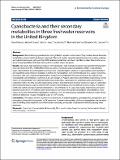Por favor, use este identificador para citar o enlazar a este item:
http://hdl.handle.net/10261/237029COMPARTIR / EXPORTAR:
 SHARE SHARE
 CORE
BASE CORE
BASE
|
|
| Visualizar otros formatos: MARC | Dublin Core | RDF | ORE | MODS | METS | DIDL | DATACITE | |

| Título: | Cyanobacteria and their secondary metabolites in three freshwater reservoirs in the United Kingdom |
Autor: | Filatova, Daria CSIC ORCID; Jones, Martin R.; Núñez, Óscar; Farré, Marinella CSIC ORCID; Janssen, Elisabeth M.-L. | Palabras clave: | Cyanotoxins Surface water Cyanopeptide Mass spectrometry Water quality Natural toxin Emerging contaminant |
Fecha de publicación: | 9-mar-2021 | Editor: | Springer Nature | Citación: | Environmental Sciences Europe 33 (29) (2021) | Resumen: | Background Bloom-forming cyanobacteria occur globally in aquatic environments. They produce diverse bioactive metabolites, some of which are known to be toxic. The most studied cyanobacterial toxins are microcystins, anatoxin, and cylindrospermopsin, yet more than 2000 bioactive metabolites have been identified to date. Data on the occurrence of cyanopeptides other than microcystins in surface waters are sparse. Results We used a high-performance liquid chromatography–high-resolution tandem mass spectrometry/tandem mass spectrometry (HPLC–HRMS/MS) method to analyse cyanotoxin and cyanopeptide profiles in raw drinking water collected from three freshwater reservoirs in the United Kingdom. A total of 8 cyanopeptides were identified and quantified using reference standards. A further 20 cyanopeptides were identified based on a suspect-screening procedure, with class-equivalent quantification. Samples from Ingbirchworth reservoir showed the highest total cyanopeptide concentrations, reaching 5.8, 61, and 0.8 µg/L in August, September, and October, respectively. Several classes of cyanopeptides were identified with anabaenopeptins, cyanopeptolins, and microcystins dominating in September with 37%, 36%, and 26%, respectively. Samples from Tophill Low reservoir reached 2.4 µg/L in September, but remained below 0.2 µg/L in other months. Samples from Embsay reservoir did not exceed 0.1 µg/L. At Ingbirchworth and Tophill Low, the maximum chlorophyll-a concentrations of 37 µg/L and 22 µg/L, respectively, and cyanobacterial count of 6 × 104 cells/mL were observed at, or a few days after, peak cyanopeptide concentrations. These values exceed the World Health Organization’s guideline levels for relatively low probability of adverse health effects, which are defined as 10 µg/L chlorophyll-a and 2 × 104 cells/mL. Conclusions This data is the first to present concentrations of anabaenopeptins, cyanopeptolins, aeruginosins, and microginins, along with microcystins, in U.K. reservoirs. A better understanding of those cyanopeptides that are abundant in drinking water reservoirs can inform future monitoring and studies on abatement efficiency during water treatment. | Versión del editor: | https://doi.org/10.1186/s12302-021-00472-4 | URI: | http://hdl.handle.net/10261/237029 | DOI: | 10.1186/s12302-021-00472-4 |
| Aparece en las colecciones: | (IDAEA) Artículos |
Ficheros en este ítem:
| Fichero | Descripción | Tamaño | Formato | |
|---|---|---|---|---|
| Filatova2021_Article_CyanobacteriaAndTheirSecondary.pdf | Artículo principal | 1,31 MB | Adobe PDF |  Visualizar/Abrir |
| 12302_2021_472_MOESM1_ESM.pdf | Material suplementario | 2,34 MB | Adobe PDF |  Visualizar/Abrir |
CORE Recommender
SCOPUSTM
Citations
31
checked on 28-may-2024
WEB OF SCIENCETM
Citations
21
checked on 27-feb-2024
Page view(s)
69
checked on 26-may-2024
Download(s)
117
checked on 26-may-2024
Google ScholarTM
Check
Altmetric
Altmetric
NOTA: Los ítems de Digital.CSIC están protegidos por copyright, con todos los derechos reservados, a menos que se indique lo contrario.


